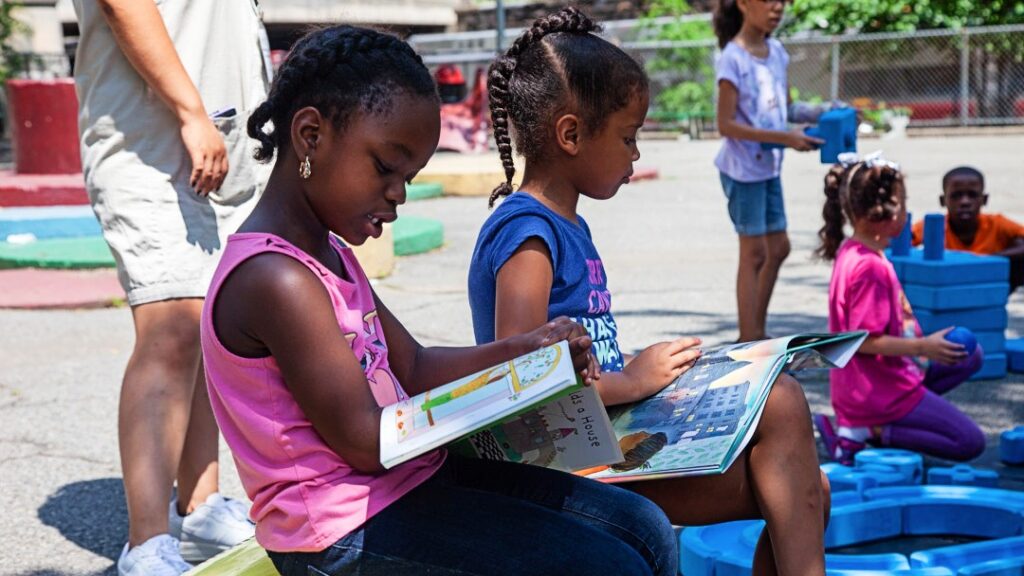How Physical Activity In Reading Lessons Help Young Learners Thrive
Educators have discovered that physical activity makes it easier for young children to focus during reading lessons.

Schools usually break learning into clearly defined periods: one for reading, one for math, one for PE, and so forth. However, some educators are beginning to mix things up a bit after discovering that physical activity makes it easier for young children to learn how to read. Given how far reading and math scores fell during the pandemic, it’s vital for instructors to find new ways of helping kids catch up.
In a literacy story published by Edutopia, educator Linnea Lyding shared how adding movement to reading lessons helped her struggling students concentrate. The innovative instructor modified common exercises, such as push-ups, jumping jacks, and squats to include oral phonemic awareness activities. These activities started every reading lesson she taught.
As this video illustrates, a phoneme is the smallest unit of sound in the English language. Children must learn phonemes to sound out words during reading instruction. Phonemes used to be called letter sounds, but “phoneme” provides a broader definition of sound. It includes non-letter sounds, such as a dog barking or an engine running.
Phonemic awareness strengthens the brain’s neural pathways. It’s also a vital foundational step for the orthographic mapping of words. While this term sounds daunting, it simply means the way our brains store written words in a way that builds gradually. Once a word has been orthographically mapped into your brain, reading it is effortless, without any decoding necessary.
Lyding’s creative method helps her reading class break words into segments that make for easier brain mapping. She explains how she used push-ups to help kids segment phonemes. “One of the students had chosen push-ups as the way he wanted to segment the phonemes in the word ship. That meant that our first push-up had three stops on the way up. We pushed up a third of the way and said “/sh/.” We pushed a little farther and said “/i/.” Then, as we completed the push-up, we all said “/p/.” For the second push-up, we blended the word using one strong push-up and said ’Ship!’”
If Lyding’s students aren’t cognitively ready for phonemic awareness, she finds other ways to incorporate movement into her reading lessons. For example, she has them shift their weight from foot to foot as they recite rhyming words. Students aren’t required to participate in the physical portion of their reading instruction, but few sit out on the fun.

Dr. John J. Ratey, an associate clinical professor of psychiatry at Harvard Medical School, has extensively explored the connection between the brain and exercise. In his book, Spark: The Revolutionary New Science of Exercise and the Brain, he provides evidence that physical activity helps all children—particularly special education students. He states that exercise improves reading and learning on three levels. “First, it optimizes your mindset to improve alertness, attention, and motivation; second, it prepares and encourages nerve cells to bind to one another, which is the cellular basis for logging in new information; and third, it spurs the development of new nerve cells from stem cells in the hippocampus.”
Ratey says that in addition to preparing the mind for learning and reading, exercise helps the brain retain information longer. It also is a powerful mood-lifter and increases physical well-being. At a time when recess is being canceled across the nation, teachers and administrators should reverse course and offer children more physical activity at school, not less.
Exercise doesn’t just affect the reading ability of young learners, as any adult who’s gone on a walk during their lunch break can attest. Montpelier High School in Vermont reaped benefits when it began giving students a 15-minute recess every day. The short break called MHS Unplugged included plenty of physical activity options, such as yoga, frisbee, soccer, or walking around the school grounds. Less-physical activities like knitting and meditation still provided a valuable brain break that left students and teachers equally recharged.







